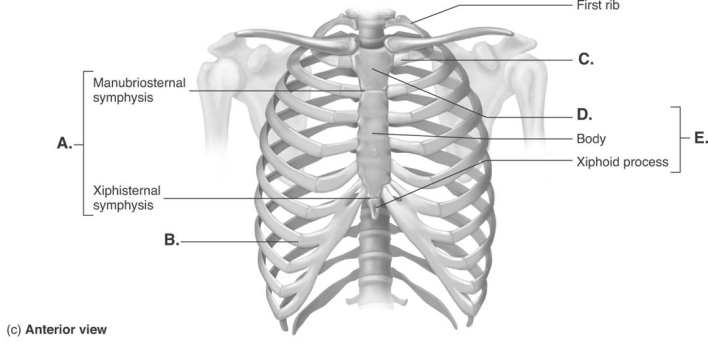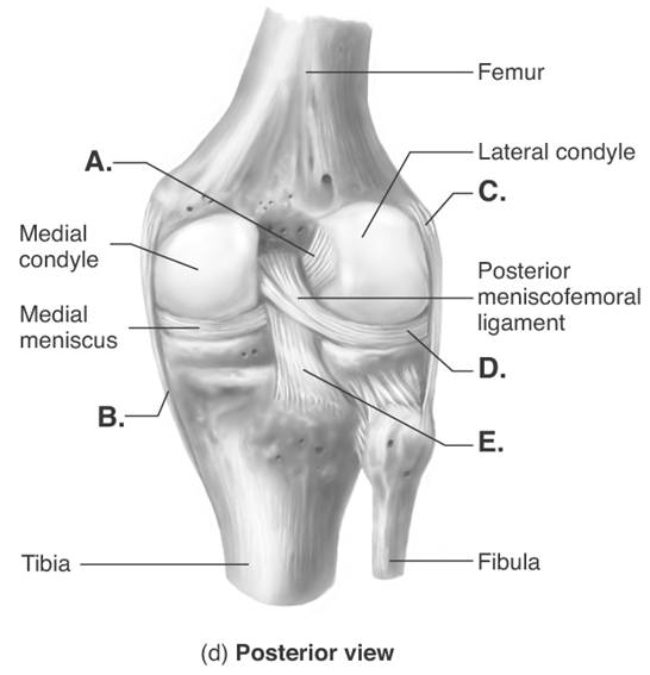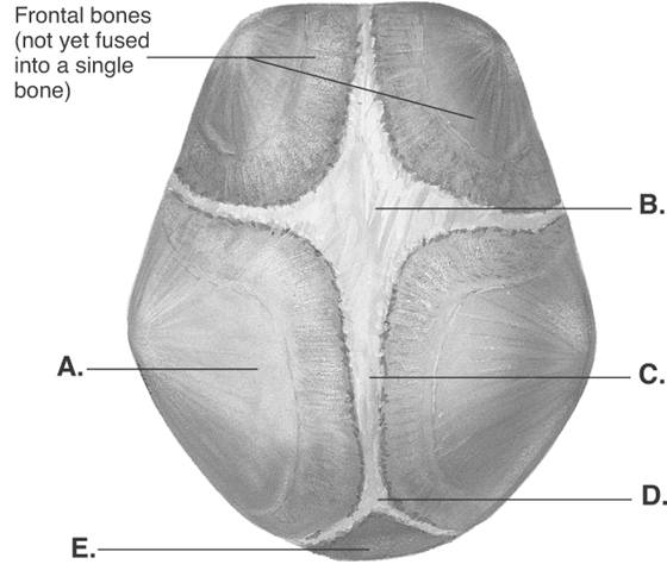A) is a double layer of tissue that encloses a joint.
B) is a thin lubricating film covering the surface of a joint.
C) provides a smooth surface where bones meet.
D) is a layer of tissue that is continuous with the periosteum.
E) lines the joint everywhere except over the articular cartilage.
G) A) and B)
Correct Answer

verified
Correct Answer
verified
Multiple Choice
The joint between the teeth and the mandibular alveolus is an example of a
A) suture.
B) syndesmosis.
C) gomphosis.
D) synostosis.
E) symphysis.
G) A) and C)
Correct Answer

verified
Correct Answer
verified
Multiple Choice
 -The figure illustrates the joints and bones of the rib cage. What does "C" represent?
-The figure illustrates the joints and bones of the rib cage. What does "C" represent?
A) costochondral joint
B) sternum
C) manubrium
D) sternal symphyses
E) sternocostal synchrondrosis
G) A) and C)
Correct Answer

verified
Correct Answer
verified
Multiple Choice
Hyaluronic acid
A) contributes to the rigidity of a joint.
B) is found in the synovial membrane.
C) is responsible for the lubricating properties of synovial fluid.
D) makes up most of the matrix of hyaline cartilage.
E) makes surfaces rough.
G) A) and E)
Correct Answer

verified
Correct Answer
verified
Multiple Choice
The medial meniscus is in the
A) neck.
B) shoulder.
C) hip.
D) knee.
E) elbow.
G) A) and C)
Correct Answer

verified
Correct Answer
verified
Multiple Choice
Shrugging the shoulders is an example
A) elevation.
B) adduction.
C) supination.
D) extension.
E) pronation.
G) C) and E)
Correct Answer

verified
Correct Answer
verified
Multiple Choice
The ligament at the head of the femur is the
A) ligamentum femoris.
B) ligamentum teres.
C) ligamentum acetabulum.
D) ligamentum ilium.
E) ligamentum primis.
G) B) and C)
Correct Answer

verified
Correct Answer
verified
Multiple Choice
 -The figure illustrates a posterior view of the right knee joint. What does "E" represent?
-The figure illustrates a posterior view of the right knee joint. What does "E" represent?
A) medial (tibial) collateral ligament (MCL)
B) posterior cruciate ligament (PCL)
C) anterior cruciate ligament (ACL)
D) lateral (fibular) collateral ligament (LCL)
E) lateral meniscus
G) A) and D)
Correct Answer

verified
Correct Answer
verified
Multiple Choice
Which of the following joints is most movable?
A) suture
B) syndesmosis
C) symphysis
D) synovial
E) synchondrosis
G) A) and E)
Correct Answer

verified
Correct Answer
verified
Multiple Choice
Which of the following statements concerning bursae is true?
A) They are filled with air.
B) They are a cellular cushion.
C) They carry blood vessels to joints.
D) They are formed by an extension of the synovial membrane.
E) They bind tendons to ligaments.
G) A) and E)
Correct Answer

verified
Correct Answer
verified
Multiple Choice
Which of the following joints is most movable?
A) plane
B) saddle
C) hinge
D) pivot
E) ball and socket
G) None of the above
Correct Answer

verified
Correct Answer
verified
Multiple Choice
Joints between the carpal bones are
A) costocarpal joints.
B) intermetacarpal joints.
C) metacarpalphalangeal joints.
D) intercarpal joints.
E) intracarpal joints.
G) B) and D)
Correct Answer

verified
Correct Answer
verified
Multiple Choice
A synchondrosis
A) is a type of gomphosis.
B) is freely movable.
C) may be temporary.
D) is found in the arm.
E) is not found in a growing long bone.
G) A) and B)
Correct Answer

verified
Correct Answer
verified
Multiple Choice
Which of the following movements is an example of extension?
A) bending forward at the waist
B) kneeling
C) raising your arm laterally
D) using your finger to point out an area on a map
E) shrugging your shoulders
G) C) and E)
Correct Answer

verified
Correct Answer
verified
Multiple Choice
Which of the following is mismatched?
A) shoulder joint - coracohumeral ligament
B) elbow joint - radial collateral ligaments
C) hip joint - cruciate ligaments
D) knee joint - patellar ligaments
E) ankle - calcaneofibular ligament
G) D) and E)
Correct Answer

verified
Correct Answer
verified
Multiple Choice
Turning the ankle so that the plantar surface faces laterally is
A) eversion.
B) inversion.
C) supination.
D) retraction.
F) B) and C)
Correct Answer

verified
Correct Answer
verified
Multiple Choice
Which of the following is NOT a cartilaginous joint?
A) epiphyseal plates
B) intervertebral disks
C) fontanelles
D) sternocostal joint
E) manubriosternal joint
G) B) and E)
Correct Answer

verified
Correct Answer
verified
Multiple Choice
Osteoarthritis usually is caused by
A) wear and tear of the joint.
B) increased uric acid in the blood.
C) an autoimmune disorder.
D) a bacterial infection in the joint.
E) bursitis.
G) A) and D)
Correct Answer

verified
Correct Answer
verified
Multiple Choice
The three arches of the foot
A) transfer weight from the tibia to the femur.
B) distribute the weight of the body during standing and walking.
C) form a hinge joint.
D) are highest on the lateral side of the foot.
E) form after birth.
G) B) and D)
Correct Answer

verified
Correct Answer
verified
Multiple Choice
 -The figure illustrates bones, fontanels, and sutures on the fetal skull. What does "C" represent?
-The figure illustrates bones, fontanels, and sutures on the fetal skull. What does "C" represent?
A) anterior fontanel
B) posterior fontanel
C) parietal bone
D) sagittal suture
E) occipital bone
G) A) and D)
Correct Answer

verified
Correct Answer
verified
Showing 81 - 100 of 119
Related Exams